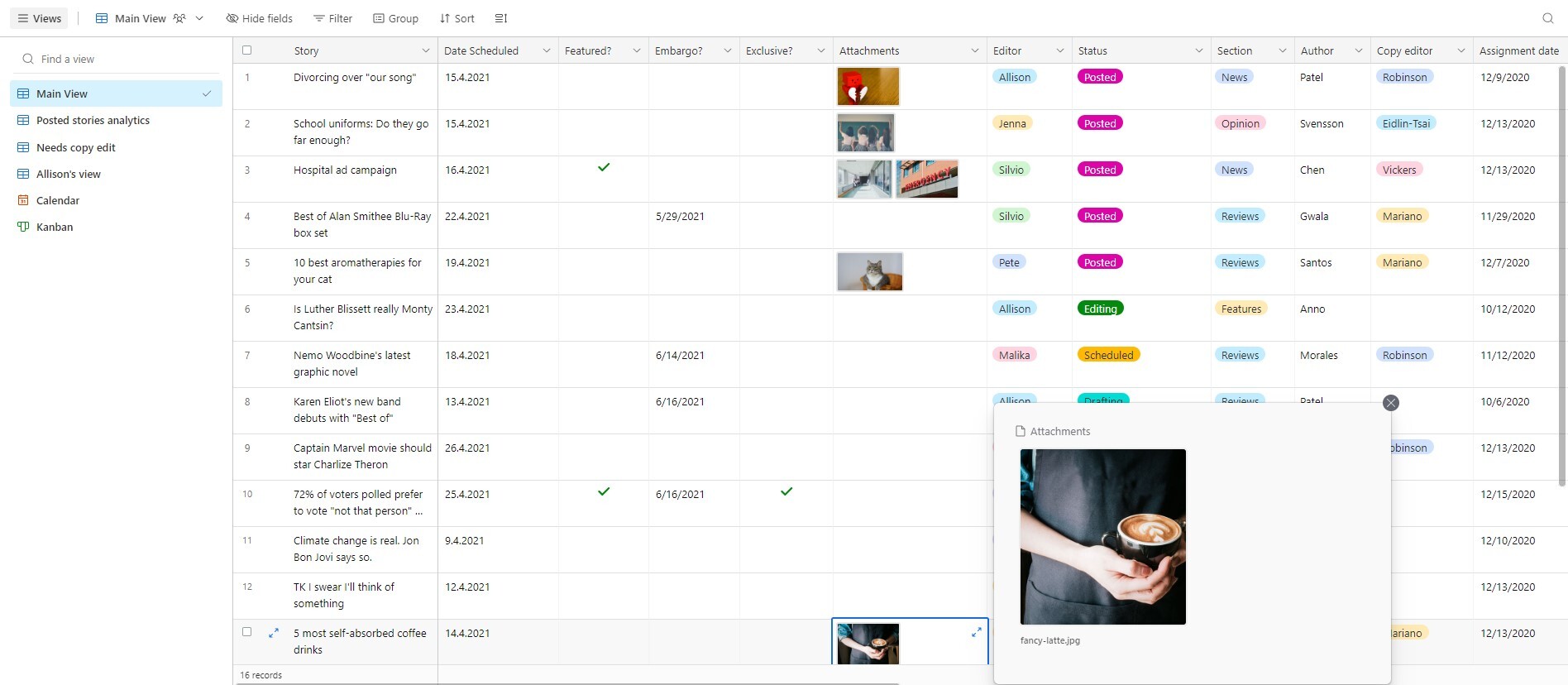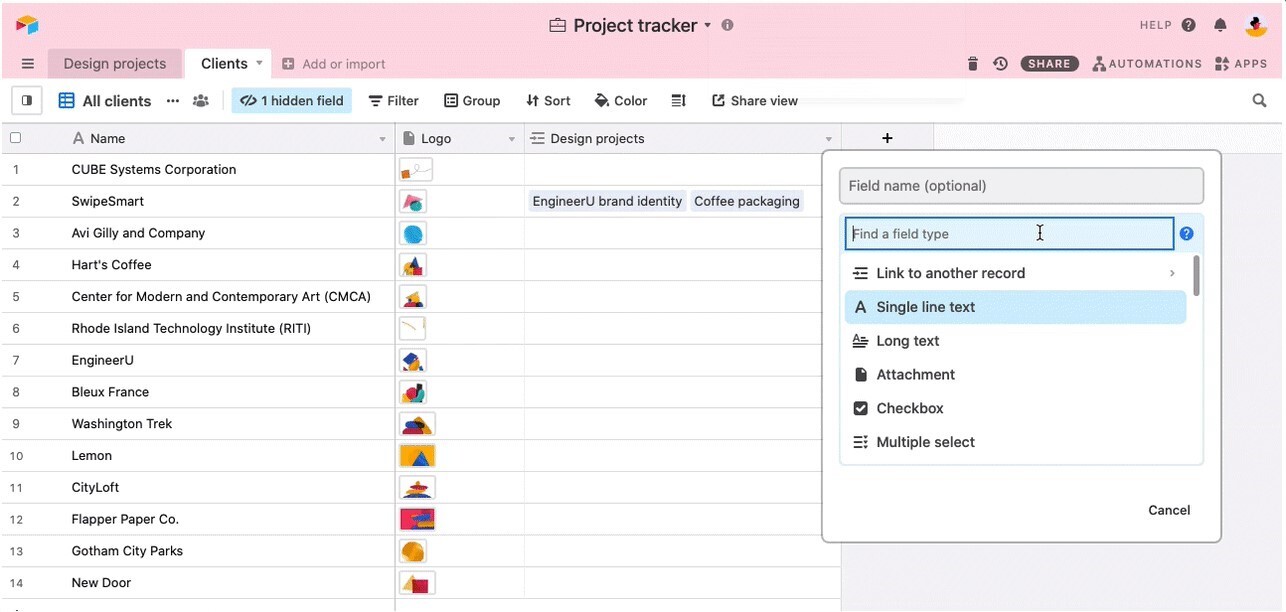Top 5 Use Cases of Airtable for Marketing
Recent Posts
List of Detective Movies Solving Criminals with a Phone Tracker Digital Marketing Companies in Toronto Ad Agencies in London Ontario Global Talent Acquisition: Technology, Data, and Strategy for Success How Effective Marketing Strategies Help Small Businesses Gain Access to Lending Programs Leveraging Link Exchanges for Enhanced Ad Campaigns Enhancing User Engagement Through Intelligent Conversation Analysis How to Deal with Career Stagnation: Strategies for Moving Forward Blueprint for Success: The Art of Mockups Customizing Your Intranet Platform for Enhanced User Experience A Comprehensive SEO SWOT Analysis The Future of Newspaper Advertising in 2024Airtable is an online collaborative platform. It is a no-code toolkit that combines the functionality of a spreadsheet with a relational database.
Consider Airtable as a digital playground that provides you with any functionality you’re familiar with, just like Lego.
Whether you manage a marketing team workload, undertake marketing data collection, or organize a CRM system, Airtable lets you build a versatile solution or start with already pre-built marketing templates for any tasks.
That’s why we’ve decided to explore 5 use cases of Airtable for marketing, so you can consider this app for your needs.
Benefits of Airtable
Airtable is a good marketing tool for anyone who wants to organize, analyze and share information efficiently. Thanks to its flexibility and ease of use, the abilities of your digital marketing will grow endlessly.
We focus on direct response and customer acquisition in e-commerce, lead gen, and mobile. When it comes to results and leads, we speak your language.
Here are some of the most notable benefits of Airtable for marketers:
- Adaptability. Create tailor-made solutions to meet the specific needs of your sphere/activity.
- Real-time collaboration. Work together and share information easily with your team or colleagues.
- Powerful integrations. Connect with other apps and services to automate and improve your workflows.
- Accessibility. Import/export your data from anywhere and at any time thanks to the online platform and mobile applications
- No technical prerequisites. The intuitive interface and wide range of ready-made tutorials make Airtable an easy-to-use marketing solution.
All you have to do is come up with a task and let Airtable do the rest.
Airtable vs. Excel
Airtable alternatives come with any software at the crossroads of a super flexible spreadsheet and a database manager. People rightly consider it a worthy successor to Excel.
Strategically, Airtable has chosen one of the most well-known spreadsheet interfaces. The well-known Excel-looking spreadsheet became its entry point. But since Airtable launch, it has outgrown Excel in systematizing workflows and easiness of use.
With traditional Excel, the large number of sheets and columns can make finding the information you need hard. Besides, using it would require extra fees for integration and reporting automation. In terms of a full-scale marketing team, it can additionally inflate the already significant marketing spend.
And even if it still holds firm ground in business analytics, Airtable enables users to manage data more efficiently and intuitively. Thanks to features such as databases, fields, views, and templates, users can find the information they need and better organize their data to solve the tasks we will describe lower.
How to Use Airtable for Marketing?
Based on Airtable’s benefits, it is versatile and useful in various applications. Regarding marketing, here are 5 examples of use cases that you should consider trying.
Management solution for marketing teams
Using a marketing solution that stores and helps manage the team is essential. Automating your planning and execution can speed up marketing activities while reducing spending.
Airtable makes planning, organizing, and tracking projects easy, allowing you to set tasks, deadlines, and responsibilities. The solution provides a central repository for ideas for the entire team.
Take the example of a company that wants a marketing management solution to streamline its team activities and digital marketing strategy. With Airtable, this company could create a dedicated workspace for each squad, such as SEO, content marketing, etc. Each workspace would then contain databases specific to the needs and responsibilities of each team.
Thus, the marketing department might have databases tracking marketing campaigns and managing other activities with Airtable.
Content planning and organization
You can use Airtable for all aspects of content planning. It helps to manage any tasks from task delegation to promotion.
The Grid mode is ideal for having an overview of your ideation process in the making, while the Calendar allows you to visualize the preferred timeline for them to result in real posting materials. This way, you can identify the publication and promotion dates.
The Kanban organizes statuses and stages (in progress, scheduled, published, etc.), making it easy to track tasks and meet deadlines.
The Gallery is particularly suitable for visual content, such as images and videos, by previewing each media element as in the screenshot below.

Content calendar example. Source: Airtable
So Airtable is a reliable tool for organizing and planning content. Besides, it relates not only to blog or website content but social media content planning and following your video strategy.
Data analytics and reporting
Another application of Airtable for marketers is data analysis. Airtable allows importing data from other formats, such as CSV or XLSX. To import data, click “Import spreadsheet” and follow the instructions.
You can easily connect Airtable with other apps to automate data import, saving time and preventing input errors. It’s doable with internal functionality and through third-party integrations. For instance, you can export Airtable to Excel to build Excel dashboards or use it further in Power BI. Additionally, Airtable integrates with many other popular apps and services – from messengers to file storage.
These integrations allow you to connect your Airtable databases to your existing tools. You will get the ultimate place to automate repetitive tasks and centralize information from different sources.
By leveraging automation and integrations, you can create efficient workflows. This helps save time by reducing manual tasks and potential errors. Interfaces are a powerful way to customize and present your data in Airtable. Create interactive and engaging views that meet your specific project needs. With interfaces, you can design dashboards, reports, forms, and other custom views using visual components such as charts, maps, galleries, and lists.
A simple CRM
When the leads flow rapidly, the marketing and sales departments can be overwhelmed. Usually, it’s not enough just works with existing leads since they tend to disappear. Without proper documentation and organization, a company can lose a customer. That’s why businesses use CRM systems, and Airtable can be a simple solution for that.
You can make a personalized CRM system on the base of Airtable functionality. It’ll be a convenient way to track interactions with customers, prospects, and partners. You can create detailed contact cards, track sales opportunities, and analyze trends.
In such a CRM as Airtable, you can not only collect contact details but also organize them according to selected criteria and track the lead’s path on the purchase path. Additionally, you can store customer feedback, NPS score questions, and other customer interactions in Airtable.
Using this functionality, you also receive a hub of interaction between sales and marketing teams. It’s convenient to stay updated, check performance results, and share outcomes with C-level executives.
Partnership documentation
Finally, all the mentioned characteristics of Airtable for marketing converge at the point of convenient work distribution space. Its secure cloud environment will enable marketers to always keep a hand on the current stage of activities.
It is useful for both in-house marketers and for handling marketing collaborations with specialists outside your organization.
Particularly, Airtable can become a place for:
- co-marketing documentation
- task tracking for freelancers
- affiliate marketing reporting
- any other cases of partnership
Documentation, rules, agreements, and task progress are available for instant review. Airtable’s access and control measures will help you to set up a secure place for collaborations. With its flexibility and customizable features, Airtable can be adapted to almost any organization and data management need.
Airtable Downsides
Yes, Airtable is not perfect. And it’s better that you know its few flaws before you get started.
The solution is not really “turnkey”
This is the flip side of flexibility. Since the possibilities of Airtable for marketers are vast, it requires some time to be well mastered. It happens to other software as well. In the case of Airtable, marketers can turn to a set of other solutions covering a specific set of needs. If you still want to master Airtable, you must conquer the learning curve, which can benefit you afterward. Also, you need to understand what your main use cases of Airtable are.
Not as “malleable” as Excel
Airtable is often compared with Microsoft Excel. We also did this above. They have a lot of similarities at first sight. However, Excel gives you an opportunity to format and process your data entirely as you wish. It does not mind exposing your data and formulas to the risk of damage.
Project tracking collaboration template. Source: Airtable
Airtable limits fancy actions a bit. The reason is that it protects the integrity of your records so you could process them in a database way. However, this advanced data manipulation functionality might not be the case for many marketers. Meanwhile, the convenience and clarity of basic use are valid factors.

Recap: Is Airtable a Great Tool for Marketing?
Airtable goes further than just a spreadsheet. It is both a powerful and easy-to-use tool, providing marketing professionals with flexibility and clear functionality.
This makes Airtable stand out from traditional spreadsheets by offering a marketing functionality – from simple documentation to marketing data analysis.
The key to success with Airtable is adaptation. Feel free to explore the different features, customize your databases, and adjust your workflows. With time and practice, you will recognize Airtable pros and discover new ways to use it for marketing.
Let us know what spreadsheets you use and your experience with Airtable in the comments.
Dmytro Zaichenko is a Marketing Specialist at Coupler.io, an all-in-one data analytics and automation platform. He has over 3 years of experience in digital marketing, particularly in SaaS. Apart from experimenting with marketing tactics, he’s a huge NBA fan.

